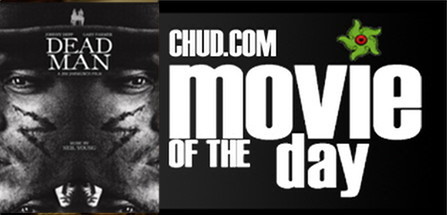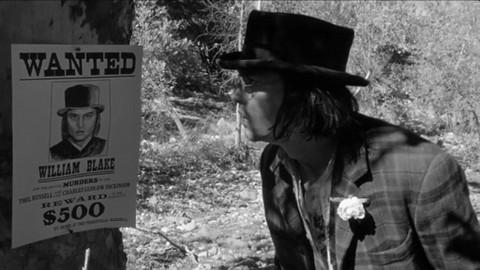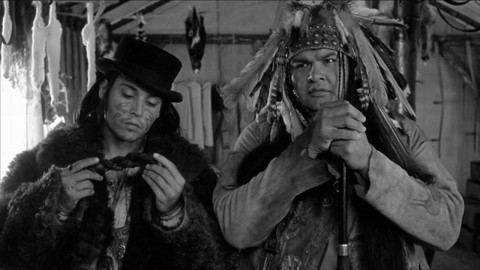
The Principles: Jim Jarmusch (writer/director), Johnny Depp, Gary Farmer, Lance Henriksen, Michael Wincott, Robert Mitchum, Iggy Pop, Billy Bob Thornton, Crispin Glover, Gabriel Byrne, John Hurt, Eugene Byrd, Alfred Molina
The Premise: William Blake (Depp) is in a bit of a rut. Not only has he recently lost his parents, he has also been ditched by his fiancé, prompting a move from Cleveland out west to the frontier town of Machine, where Blake was promised a job working as an accountant for Charles Dickinson’s (Mitchum) metal-working company. In case things weren’t bad enough for our poor, unassuming city boy, Blake is told upon arrival that his position has already been filled. He seeks comfort in the bed of a former prostitute (Avital), only to find himself face to face with her armed and despondent boyfriend (Byrne) the next morning. Shots are fired, the boyfriend (also Dickinson’s son) is killed, and a seriously wounded Blake goes on the lam. After finding him unconscious in the woods, a Native American named Nobody (Farmer) will guide Blake on his journey home. What is meant by “home,” however, depends on which of these two men you ask.

Is it any good? Absolutely. Jarmusch has crafted a gorgeous, haunting fever dream of an acid western. Dead Man isn’t simply influenced by the works of writer William Blake, it may be the closest one can get to actually putting poetry to film. The lyrical flow of the script, the masterful handling of grays by cinematographer Robert Muller, and the constant fade outs that essentially break the film into stanzas all lure the viewer into a trance-like state much like that of the wounded Blake. All of this is accompanied beautifully by a minimalist soundtrack composed and performed by Neil Young.
A meditation by Jim Jarmusch on Native American thought and the issues inherent in the expansion of white America is automatically going to be fairly dense with subtext. Framing it with the works of one of England’s greatest poets really runs the risk of pushing the whole thing overboard into a swamp of muddy metaphors. This is my third time watching Dead Man, and there is still the occasional sequence that leaves me scratching my head, but for the most part Jarmusch balances it all quite deftly. The relationship between Blake and Nobody is obviously the center of the film, as Nobody attempts to help Blake (who Nobody believes is the lost spirit of the actual poet) return to the spirit world.
As Blake continues westward through the wilderness, the price on his head rises, drawing the attention of bounty hunters, marshals, and just about everyone else who wants to make a buck or two. Lance Henriksen’s cannibal bounty hunter (yes, Jarmusch has confirmed all of our suspicions that Henriksen does, in fact, consume human flesh), Cole Wilson, is quite menacing, and leaves me convinced that he would be the perfect Saint of Killers in the probably-never-going-to-happen Preacher movie/series. Michael Wincott also entertains, providing uncharacteristic comic relief as fellow bounty hunter Conway Twill. Whenever guns are drawn, Jarmusch displays the violence as sloppy and awkward, standing in stark contrast to the glamorous and stylized violence presented by many of his contemporaries.

The tradition of the early Western presents the exploration of the west as a journey towards the frontier of freedom and opportunity, with the “savage” Native Americans set up as foils to the white hero. In Dead Man, Jarmusch has inverted these tropes. By displaying the white man as the perpetrator of savagery and presenting the frontier as building grounds for hellish towns like Machine, Jarmusch has created in Dead Man a beautiful, poetic critique of industrialization, capitalism, and the dualism espoused by Western culture.
Is it worth a look? If you have an aversion to leisurely-paced, minimalist films that rely more on imagery and lyrical prose than plot, you may want to sit this one out. Otherwise, it is definitely worth checking out. Though familiarity with Blake’s work will undoubtedly improve your appreciation for the film, it is by no means necessary in enjoying it. Oh, did I mention that in addition to cannibal Henriksen, you also get Michael Wincott’s sleepy-time teddy bear, cross-dressing Iggy Pop’s baked beans, and Robert Mitchum talking to a stuffed bear? Because yeah, all of those things.
Random anecdotes: Farmer’s “Nobody” reappears in Jarmusch’s Ghost Dog, repeating his oft-said line “Stupid fucking white man.”
Most of Neil Young’s soundtrack is first-take improvising done as he watched the film alone in the studio.
In the mid to late 1800s, the government encouraged people to kill as many buffalo as possible in order to destroy the Native American population’s biggest supply of food and material. This is the basis for the opening sequence in which the train passengers unleash a barrage of gunfire out of the windows when passing a herd of buffalo.
Jarmusch deliberately left the Native American language without subtitles, as he wanted it to have in-jokes for Native American viewers.
Cinematic soulmates: Meek’s Cutoff, Ghost Dog: The Way of the Samurai, The Brave, The Shooting